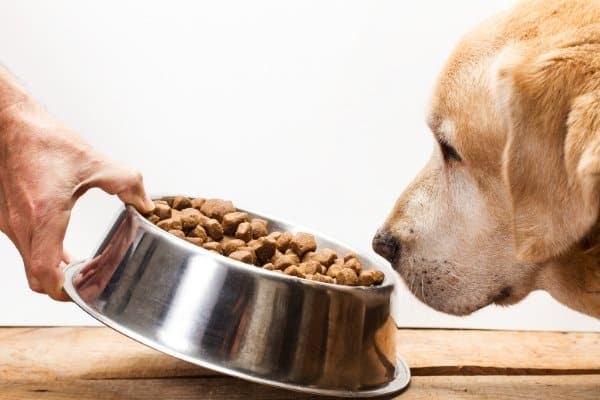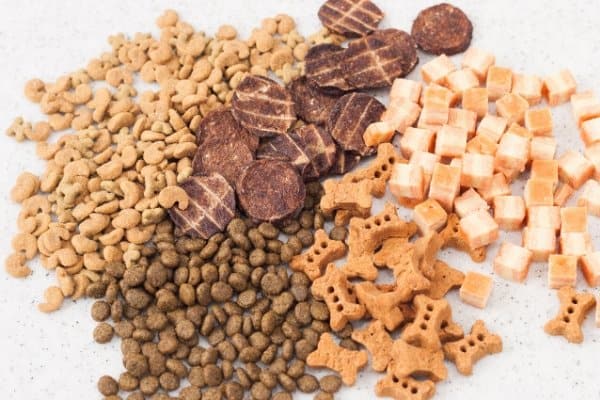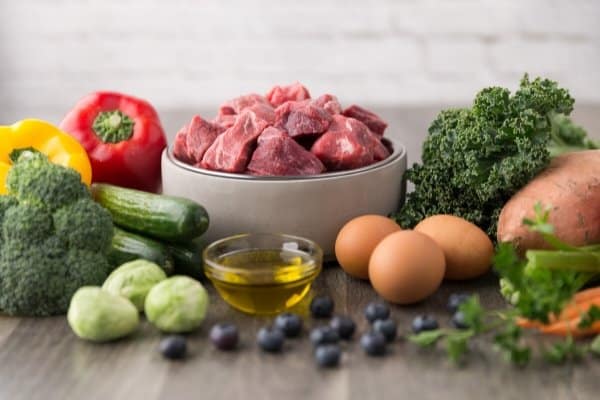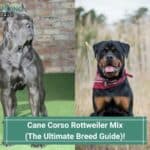As a devoted dog owner, you naturally want your pup to be as healthy and happy as possible. For your dog to fulfill his expected lifespan, he needs a complete and balanced diet that supplies all essential canine nutrients.
Your pal’s chances of longevity can be further increased by eating high-quality, wholesome food.
Generally, the healthiest commercial dog foods and treats are low in meat by-products, unspecified meat sources, meat meal, and grain fillers, such as wheat and corn.
They’re also free of dyes, artificial flavors, synthetic sweeteners, and chemical preservatives. Additionally, the best dog formulas are processed at low heat, protecting their nutrient potency while killing potential pathogens.
To help you identify the best canine foods on the market, we’ll give you tips for deciphering product labels and profile the various types of dog foods available along with their strong and weak points.
We’ll also provide information on homemade diets and treats and cover three supplements to consider giving your pup, provided your vet approves.
In no time at all, you’ll be an expert on choosing the optimal food for your dog! Let’s get started.
Table of Contents
Label Sleuthing
Labeling can be admittedly confusing, but knowing how to decipher the listed ingredients is important for the health of your dog.
Basic Canine Nutrition
You’ll find clues to quality on dog food labels. On the packaging, manufacturers are legally required to disclose the ingredients in their products, listed in descending order by weight.
In a choice formulation, the first ingredient will be meat, fish, or poultry.
Along with high-quality protein, your dog needs healthy fat, for energy, brain function, skin integrity, and a shiny coat. Omega fatty acids in particular are vital.
Note that the word “meal” after a meat source indicates an inferior grade of meat, a type of animal byproduct. Among meals, there are various levels of poor quality.
However, there’s a secret to discerning how substandard a meat source is! We’ll explore this further under “Animal Byproducts.”
Trustworthy manufacturers conduct animal feeding tests and comply with specifications by AAFCO, the Association of American Feed Control Officials.
This organization sets nutritional standards for pet foods and regulates their ingredients.
When reading labels, look for the following statement or similar language:
“This product provides complete, balanced nutrition, as verified by feeding trials conforming to AAFCO standards and procedures.”
Plant Proteins
As canines are primarily carnivorous, they’re more efficient at metabolizing the nutrients in animal products than plants.
Some dog food manufacturers use plant proteins as a meat substitute to save money.
For example, soy is a cheap protein source. However, it can adversely affect canine hormones, especially estrogen and thyroid hormones. Additionally, for some dogs, soy is an allergen.
The Grain Debate
Grain products are controversial in dog foods. We recommend you avoid them as they tend to trigger canine allergies.
Although grains supply fiber, pet food producers often use them as fillers, a way to add volume at low cost.
Common fillers in dog food are corn bran, rice bran, wheat mill run, oat hulls, soybean hulls, and modified cornstarch.
Especially allergenic are glutinous grains, such as wheat and corn gluten meal.
Special Note: Premium dog foods tend to omit grains altogether.
How can you tell if your pup has a food allergy? Most commonly, allergic reactions show up in canine skin, leaving it red, dry, and itchy. Another typical reaction is chronic ear infections.
Dyes
The dyes in dog food are meant for our benefit. Dogs don’t care if their food looks pretty.
In fact, the only colors that dogs can distinguish are shades of green, blue, and yellow. However, bright colors give us the mistaken impression that dog food is healthy and appealing!
So, avoid products with artificial colors on the labels, especially FD&C Red #3 and #40, which carry a cancer risk. Other dyes can increase canine susceptibility to viruses. Typically, healthy dog foods will be brown.
Animal Byproducts
These meat scraps are the remains of slaughtered animals unfit for human ingestion. Another term for animal byproducts is “offal.”
Examples of animal byproducts include:
- Bones.
- Heads and brains.
- Feet.
- Lungs.
- Stomachs and intestines.
- Spleens, kidneys and livers.
- Undeveloped eggs.
To save money, cheap dog food manufacturers substitute offal for meat.
Another type of animal byproduct is meat meal. To make offal edible for pets, manufacturers render it.
This process entails cooking off the water, skimming the fat, and baking the residue. There are two grades of meals – feed and pet food.
While pet-food grades have more nutritional value than feed grade, neither meal grade is healthy.
In dog food, you can identify pet-food grade meal when the animal source is clearly named, as in:
- Beef byproduct meal.
- Poultry byproduct meal.
- Turkey byproduct meal.
- Chicken byproduct meal.
With feed grade meals, the meat source isn’t specified. Such offal can be rendered from diseased livestock, dead zoo animals, euthanized pets from shelters, and road kill.
On dog food labels, feed meals can be recognized by these generic terms:
- Meat meal.
- Meat and bone meal.
- Animal byproduct meal.
- Meat byproduct meal.
Artificial Flavors
The highest quality dog foods are free of flavoring agents. As you’d suspect, the sole purpose of artificial flavors is to make the dog food more palatable.
Examples of artificial flavoring are glandular meal and animal digest. Except for natural flavors, any ingredient preceded by the term “flavor” can be assumed to be synthetic.
Sweeteners
Avoid dog foods laced with sweeteners, such as aspartame, sucralose, and saccharin.
Corn syrup, sugar, and fructose only add empty calories and promote dental plaque, a bacterial film that erodes gums and teeth.
Though not found in commercial dog food but common in many human products like toothpaste and candies, xylitol is another sweetener to avoid at all costs. It is toxic and potentially fatal to dogs.
Preservatives
To protect commercial dog foods from spoilage,the use of preservatives is necessary. In perishable foods made without preservatives, mold can breed prolifically, and fats quickly turn rancid.
Twenty years ago, all commercial dog foods were made with chemical preservatives. Now, their addition reflects poor quality.
Synthetic preservatives commonly used in dog foods are ethoxyquin, TBHQ, BHT, BHA, propylene glycol, and propyl gallate. Each of these additives is linked to severe side effects.
Ethoxyquin is especially toxic. As well as being a preservative, it’s a pesticide and hardening agent used in rubber manufacturing.
The Food and Drug Administration (FDA) is investigating ethoxyquin as potentially causing disorders of the liver, bladder, kidneys, digestive tract, and blood.
BHA and BHT are suspect for causing cancer, states the World Health Organization. In animal tests, TBHQ triggers convulsions, paralysis, and liver enlargement.
Propylene glycol also harms the liver. Propyl gallate is even worse, associated with skin irritation, cancer, and diseases of the liver and kidneys.
Other toxic preservatives to avoid are sodium nitrate, potassium sorbate, and calcium propionate.
Instead, choose dog foods containing natural preservatives. Examples are Vitamin E as “tocopherols” and Vitamin C as “citric acid” and “ascorbic acid.” Other safe preservatives are the herbs rosemary, oregano, and thyme.
Regarding wet dog food, canning effectively prevents spoilage. Still, some manufacturers unnecessarily add preservatives to canned dog food.
Types of Commercial Dog Foods
Kibble
This dry dog food is processed at extremely high temperatures. While canned dog foods are about 75% water, kibble is only 10%.
Our top kibble picks are Blue Buffalo Life Protection Formula and Purina Pro Plan, and for a grain-free option, we like Diamond Naturals Skin and Coat Formula.
Advantages
Dog food made in the United States is nutritionally complete, as regulated by AAFCO and the FDA. Some kibble formulas are tailored to dog breed, age, and specific health needs.
The food is economical, less perishable than wet food, and easily stored.
Also convenient is that kibble needs no preparation. Customizing portions is simple, following the weight guidelines on the packaging.
Some kibbles are teeth-friendly, formulated to scrape plaque from teeth as a dog bites and chews the pellets.
There’s also the neatness factor. If your dog is a messy eater, cleanup is a breeze. Plus, the kibbles can serve as handy treats and training rewards.
Disadvantages
Heat processing destroys the nutrients in fresh foods, including antioxidants, vitamins, and enzymes. For this reason, kibble is heavily fortified.
It’s also high in grains, such as rice, wheat, and corn. Kibble manufacturers use grains for three purposes – to bind food into pellets, replace meat, and improve pellet consistency.
For most dogs, the texture and odor of kibble are less appealing than wet. To remedy this drawback, producers coat pieces with unhealthy fats, gravies, and flavorings.
Some breeds have problems digesting kibble, evidenced by bloating. Others are allergic to it. Frequently, products are subject to recalls, the result of manufacturing errors and contamination.
Wet/Canned
Available in a wide variety of flavors and ingredient combinations, wet or canned dog food is high in moisture content and well liked by most dogs.
For those of you new to the world of canned dog food, we recommend Beyond by Purina and Hill’s Science Diet.
| Preview | Product | Rating | |
|---|---|---|---|

|
Purina Beyond Beef, Potato, and Green Bean Grain... | Check Price on Amazon | |

|
Hill's Science Diet Wet Dog Food, Senior Adult 7+,... | Check Price on Amazon |
Advantages
Like dry dog food, wet types are nutritionally complete and require no preparation. Unlike kibble, they tend to be lower in carbs.
Many wet dog foods are derived from fresh and frozen meat, as opposed to rendered offal. Most canned formulas are free of chemical preservatives, yet they have a long shelf life.
Disadvantages
Wet dog foods can be high in fat. Low-quality brands often contain meat byproducts. Compared to kibble, wet foods are usually more expensive.
Semi-Moist
This type of canine cuisine comes in pouches ready to be poured into your dog’s bowl. One of the most popular choices is Purina’s Moist & Meaty pouches.
| Preview | Product | Rating | |
|---|---|---|---|

|
Purina Moist and Meaty Steak Flavor Soft Dog Food... | Check Price on Amazon |
Advantages
After the pouches are opened, the food is slow to spoil. These are also quite convenient to use when traveling with your dog as they are easy to pack, light to transport, and come in meal-size portions.
Disadvantages
Semi-moist foods tend to be higher than other types in artificial colors, sweeteners, and preservatives. They’re also costly and won’t help to clean your dog’s teeth as dry kibble does.
Due to their lack of purity, they should be used sparingly, as occasional snacks or training rewards.
Dehydrated
To dehydrate pet foods, manufacturers take raw stock and slow-cook it by exposing it to warm air. Dehydration has three advantages:
- It makes raw food easier to digest.
- Nutritional value is maintained.
- It kills off pathogens.
In our opinion, Spot Farms is one the best choices as it contains no grain, antibiotics, preservatives, artificial ingredients, or animal meal and all ingredients are human grade.
| Preview | Product | Rating | |
|---|---|---|---|

|
Spot Farms 97533 Dehydrated Grain Free Beef Dog... | Check Price on Amazon |
Advantages
Blowing warm air over raw food evaporates moisture, protecting food from spoilage, rancidity, and bacterial activity.
This “curing method” concentrates nutrients and eliminates the need for preservatives.
For these reasons, dehydrated foods are more nourishing than raw. They’re also ideal for traveling, being lightweight and space-saving.
Disadvantages
Rehydration time varies, from 10 minutes to a few hours of soaking. Even when plumped, dehydrated foods can be tough and leathery, making them hard for dogs to digest.
The high-tech equipment used in manufacture jacks up the cost of dehydrated foods.
Freeze-Dried
Producing this dog food involves flash-freezing, followed by vacuuming away any ice, reducing the moisture content to roughly 5%.
If you’re interested in this freeze-dried food, Stella & Chewey’s make a 100% complete and balanced blend available in a wide variety of ingredient options.
| Preview | Product | Rating | |
|---|---|---|---|

|
Stella & Chewy's Freeze Dried Raw Dinner Patties... | Check Price on Amazon |
Advantages
Freeze-drying retains most of the nutrients in raw food, even more so than dehydration. Shelf life is also longer.
Typically, organic food predominates while grains are usually absent. Products have a high percentage of meat, including organ and muscle meats.
Most dogs love the flavor of rehydrated freeze-dried foods, even pups with meager appetites. When vacationing with your dog, freeze-dried fare is a convenient option.
Before serving these foods, most must be rehydrated in water for about three minutes. Adding water increases digestibility and satiety for dogs.
Also available are small cubes that don’t need rehydration and can be used as treats and meal toppers.
Disadvantages
Most freeze-dried ingredients are raw, including any meat. Unlike cooking, freeze-drying doesn’t kill all infectious bacteria.
Therefore, the microbes can become active with product rehydration. For this reason, freeze-dried food can be extremely harmful to dogs with weak immune systems.
Pups with sensitive stomachs may also do better with cooked foods.
Some manufacturers use high-pressure pasteurization (HPP) to prevent bacterial growth in freeze-dried foods. This procedure, known as a “kill step,” lowers the risk of microbial contamination.
The price of freeze-dried dog food is steep. Therefore, it’s best for training and short-term feeding. If you decide to use it for an extended period, only buy products labeled “complete and balanced.”
HUMAN-GRADE
AAFCO stipulates that all ingredients in human-grade pet food must be safe for human consumption.
Food manufacture must conform to standards outlined in federal regulation 21 CFR 110, specifying safe manufacturing practices for the preparation, packing, and storage of human food.
Since 2002, The Honest Kitchen has been the leader in producing human-grade food for pets.
| Preview | Product | Rating | |
|---|---|---|---|

|
The Honest Kitchen Human Grade Dehydrated Grain... | Check Price on Amazon |
Advantages
Most human-grade dog foods are either dehydrated or freeze-dried. Since processing doesn’t involve high temperatures, the foods are nutrient-rich.
Typically, the ingredients include organic meats, vegetables, and sometimes grains.
Disadvantages
Since the FDA doesn’t strictly enforce regulation 21 CFR 110, manufacturers can fool pet owners into thinking they comply with it.
How so? By claiming their dog food is “made with human-grade ingredients.” Notice that the word “only” is strangely absent.
This means some components may not be fit for human consumption. Manufacturers who strictly conform to AAFCO standards are Tylee, The Honest Kitchen, Spot Farms, and Caru.
While human-grade ingredients imply high quality, such dog food should also be nutritionally balanced and complete.
To be sure, only buy products with the following AAFCO reference on their label or something similar:
“This product has been formulated to meet the nutritional standards established by AAFCO Dog Food Nutrient Profiles.”
Refer to the Dog Food Advisor for an online resource that profiles the best formulations in several categories, such as wet food, dry food, non-allergenic, grain-free, weight loss, and breed. Product reviews include ingredient lists and recall histories.
Alternative Dog Food
RAW
This is uncooked food in its natural condition. The raw dog food diet is based on how canines ate before being domesticated.
The foundation of this regimen is raw muscle meat. Organ meat contributes vitamins, while ground bone adds calcium.
Fresh vegetables yield fiber, enzymes, antioxidants, minerals, and additional vitamins. Raw food diets may be purchased already prepared but frozen and will require defrosting before being served.
Advantages
Since raw food is unheated, it retains all the nutrients of fresh food. Being unprocessed, it lacks preservatives.
Disadvantages
As raw food is whole, it’s difficult for dogs to chew and digest. Moreover, since raw food isn’t subject to heat, it can be riddled with pathogenic organisms.
Even if a dog has strong immunity and doesn’t get sick from tainted food, their intestines can host the bacteria.
This puts a pet owner and other animals at risk of infection and even death. Among all types of pet food, raw products are most likely to be contaminated.
HOMEMADE
This labor of love entails making dog food from scratch, featuring mostly fresh and minimally processed ingredients. Some pet owners prioritize using organic meats and vegetables.
Advantages
As your dog’s chef, you can ensure a diet of only wholesome food. If your pooch has known food allergies, you can better avoid reactions since you’re censoring all ingredients.
In this regard, home-cooked meals can resolve chronic ear infections, indigestion, and skin irritation.
Disadvantages
If your dog eats homemade food exclusively, he may be at risk of malnutrition. That’s why it’s important to make sure the diet is prepared by a veterinarian nutritionist.
I’ve been feeding my dog Oliver homemade meals for over a year now and couldn’t be happier with the results. He’s healthy, fit, and drools everytime I prepare his meals.
We get our pup’s personalized recipes and supplements from Balance IT and highly recommend you do too!
Before embarking on a homemade diet, obtain your vet’s approval.
This is especially vital if your pup has any medical conditions, such as diabetes, liver disease, kidney disease, food sensitivities, or obesity.
Even if your dog appears healthy, before switching to a homemade diet, get your vet’s okay.
Most likely, the doctor will sanction serving some homemade foods.
Just remember that it’s critical to know what’s safe and unsafe for dogs to eat and working under the guidance of a canine nutrition expert is best.
Caloric Requirements
Knowing your dog’s daily calorie needs can help prolong their life.
Overweight pups have a high risk of life-threatening illness, such as diabetes, cancer, and diseases of the heart, lungs, and kidneys.
Furthermore, chubby dogs are especially prone to arthritis and hypertension.
Obesity also causes breathing difficulties, especially in brachycephalic dogs, meaning those with short noses and flat faces.
Breeds in this category include Pugs, Boston Terriers, Lhasa Apsos, French Bulldogs, Chihuahuas, Chow Chows, English Bulldogs, Boxers, Shih Tzus, Bull Mastiffs, and Pekingese.
A dog’s daily calorie quota is determined by several factors, including their size, age, metabolic rate, and lifestyle. Most calorie tables are based on the size and activity levels of adult dogs.
Since the charts don’t consider all variables, use them as a general feeding guide. Then, make adjustments according to how your dog responds.
Here’s how to calculate your dog’s daily calorie threshold:
- Weigh your pup on a bathroom scale.
- From the chart below, note their activity level and suggested calories per pound of body weight.
- Multiply that number by their total weight.
Small Breed (weighing less than 20 lbs.)
Inactive – 17 calories per pound of bodyweight
Normal – 21 calories
Active – 24 calories
Medium Breed (20 to 50 lbs.)
Inactive – 20 calories per pound of bodyweight
Normal – 24 calories
Active – 27 calories
Large Breed (more than 50 lbs.)
Inactive – 25 calories per pound of bodyweight
Normal – 32 calories
Active – 35 calories
Legally, pet food manufacturers must state the calories in food servings on their product labels. This information is mandated by the FDA and AAFCO.
After calculating your pup’s daily calorie need, you can gauge the appropriate serving size by following package guidelines.
Special Note: Puppies typically require more calories and smaller portions fed several times throughout the day.
Chubby Pup?
How can you know whether your dog is overweight? One method is checking their ribs. To do this, place your hands on your pal’s sides and note the following.
- If the ribs are hard to feel, your pup is overweight.
- If the ribs protrude and/or are visible, your pooch is underweight.
- If you can feel the ribs but can’t count the individual bones, your dog is the ideal weight.
Feeding Schedules
For the average canine, most vets advise two meals per day. However, a dog with chronic illness may need a customized frequency, specified by their doctor.
Generally, vets discourage free-feeding since daylong grazing can lead to obesity. However, some breeds are inherently less food-minded than others.
If you got your pup from a breeder, ask their opinion on free feeding.
Does your dog do well with self-regulation? If so, try portioning out non-perishable food twice daily. With the second feeding, make sure to empty and wash the bowl before refilling it.
Diet Transitioning
When switching to new dog food, do so gradually. Your pup’s digestive tract needs time to adapt to changes in food ingredients and consistency.
If you don’t allow for this, they may suffer from gastrointestinal problems. Possible symptoms are diarrhea, vomiting, loss of appetite, and lethargy.
If you just brought your pup home, for the next two weeks, continue serving the food to which they’re accustomed.
Then, over the third week, while maintaining the same volume, gradually subtract the amount of standard food, replacing it with the new formulation.
Here’s a mixing guideline:
- Day 1 – 1/4 of the new food mixed with 3/4 of the usual food.
- Day 2 – 1/3 of the new food and 2/3 of the usual.
- Day 3 – 40% of the new with 60% of the former.
- Day 4 – Half and half.
- Day 5 – 60% new and 40% former food.
- Day 6 – 3/4 new and 1/4 former food.
- Day 7 – All new.
To minimize tummy upset, consider avoiding the most allergenic foods – beef, chicken, dairy, eggs, and wheat.
While transitioning, it’s best to omit any treats and people food. Otherwise, you’re introducing new variables.
Then, if your dog shows poor digestion, you won’t know the specific source and what to eliminate. If your dog reacts severely to new foods, promptly call your vet.
Do you plan on switching from wet to dry? If so, follow the package guidelines for the dry food. If changing from dry to wet food, ask your vet for the proper amount of wet.
Otherwise, you can easily overshoot the optimal caloric intake for your dog’s age, size, and activity level.
Commercial Treats
Generally, there are two kinds of prepared dog treats — meaty and biscuits.
As with dog food, when shopping for healthy treats, scrutinize labels. Ingredients should be recognizable, specifying their source.
For example, the term “animal fat” is too vague. You don’t know the origin. If a treat has preservatives, they should be natural, as in Vitamin C and mixed tocopherols.
In the most wholesome treats, ingredients are certified organic.
Whereas sweeteners have no place in dog foods, a bit of sweetening is okay in treats since they’re meant for occasional use.
On labels, look for natural sweeteners, such as honey, molasses, maple syrup, and applesauce.
Be on the alert for glycerin, also termed glycerol. Many pet food manufacturers use glycerin to inhibit mold, bind ingredients, boost yield, sweeten treats, and impart a soft, chewy texture.
The problem is that treat labels may not specify the type or source of glycerin.
According to the FDA, vegetable glycerin is safe. However, glycerin can also be derived from petrochemical processing. Such glycerin is crude, containing a toxic liquid called methanol.
Meaty Treats
The best meaty treats have few ingredients, such as organ and muscle meats, some vegetables, and no grains. Meaty goodies can be dry or chewy.
Chewy morsels have up to 25% moisture, courtesy of “humectants,” substances that hold water.
A common humectant is propylene glycol. However, since it causes liver damage, avoid any product containing it. Safe humectants are vegetable glycerin and molasses.
My Oliver adores Nudges Steak Grillers and they’re all-natural.
Dog Biscuits
These cookie-style treats are baked. The main ingredients are carbohydrates, often accompanied by grains.
However, grain-free biscuits are also available and preferable. Generally, the moisture level in biscuits is similar to that of kibble, about 10%.
Some biscuit producers enhance flavor with animal products, such as organ and muscle meats.
Other manufacturers boost taste with low-quality ingredients, such as fat, salt, and sweeteners, so check those labels!
Homemade Treats
Generally, dog treat recipes start with a mix of flour, eggs, and broth or water.
To ensure protein, recipes add meat, cheese, or peanut butter. Often, mashed potatoes serve as a binder. Vitamins and fiber can come from apples, sweet potato, carrots, and pureed pumpkin.
There are a few caveats concerning homemade dog goodies. If using meat, thoroughly cook it, followed by removing any bones, skin, and fat.
With fruits and vegetables, eliminate any seeds, stems, and pits that could lodge in your pup’s throat. If you’re re-purposing leftovers, be sure to rinse off any sauces and seasonings.
A quick online search will give you an abundance of tasty recipes to try.
Supplements
Before buying supplements, consult with your vet. If you’re looking to remedy a particular symptom, first get a diagnosis to rule out serious illness requiring professional care.
For example, if an elderly dog is suddenly limping, you might suspect arthritis. However, the pup could have a neurological injury. If a dog develops a skin condition, there could be a hormonal cause.
Since most commercial dog foods are fortified, adding more nutrients may trigger overdosing and hazardous reactions.
For instance, excess calcium and Vitamin D can trigger bone pathology. Too much Vitamin A can cause joint pain.
Special Note: If your dog takes medication, any herbs in supplements could interfere with the drug.
However, three dog supplements are proven safe and helpful:
- Omega-3 fatty acids.
- Glucosamine.
- Probiotics.
Omega-3 Fatty Acids
These healthy fats can potentially sharpen canine vision, improve brain function, and protect against inflammation of skin and joints.
Two omega-3s with these benefits are DHA and EPA, both of which are found in fish oil.
Glucosamine Sulfate
This supplement has a 20-year history of veterinary use to prevent and treat joint damage. Glucosamine is a compound present in joint cartilage, the spongy tissue between bones with cushioning effects.
Dogs naturally produce glucosamine to repair any worn and injured cartilage.
However, the ability to make glucosamine declines with age. Since joints naturally lose cartilage over time, the resulting bone friction causes arthritis.
Supplemental glucosamine helps to restore joint cartilage, reduce arthritic pain, and facilitate mobility. Glucosamine sulfate in canine formulas typically comes from shellfish or is synthesized in labs.
Probiotics
These are healthful microorganisms that normally live in the canine digestive tract. There are many strains of probiotics, each one with specific merits.
Certain species are known to benefit canine digestion, immunity, cognition, inflammation, skin, and coat health.
Probiotic doses are measured in colony-forming units, abbreviated CFUs. For optimal effect, a supplement should contain at least one billion CFUs.
Supplement Quality
Although the FDA oversees pet supplement manufacturers, the agency doesn’t guarantee nutrient potency, quality, and safety.
Therefore, when considering supplements, look for brands certified by the National Animal Supplement Council (NASC).
On a product label, the NASC Quality Seal indicates that the supplement producer:
- Sources only top-quality ingredients.
- Adheres to safe manufacturing practices.
- Engages in ongoing quality control monitoring.
- Complies with NASC labeling standards.
- Submits to random product testing by an independent lab.
- Has passed NASC auditing.
If you’re concerned about your current supplement manufacturer, consult this up-to-date list of NASC members who have aced the auditing process.
Once you’ve found a choice brand with the NASC Quality Seal, clear the formulation with your vet.
If approved, the doctor can recommend the proper dosage, based on your dog’s breed, age, weight, and medical condition.
SUPERDOG
Now you’re an expert on the healthiest dog foods and treats. When you serve wholesome fare and partner with a vet, your pup can become a Superdog!
NOTE: The information provided here is solely for educational purposes and not meant to replace professional veterinary advice. If your dog has a specific medical problem or breed-related health concern, obtain your vet’s recommendation for optimal canine foods.
Last update on 2024-04-27 at 03:41 / Affiliate links / Images from Amazon Product Advertising API













